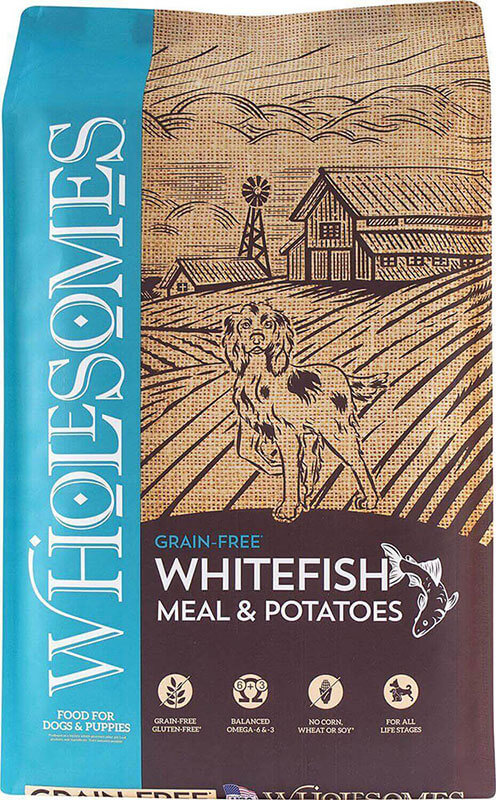
DogFoodAdvisor is reader supported See how
All reviews are 100% impartial but if you buy using links on this page, we may earn a referral fee.
Which Wholesomes Recipes Get Our Best Ratings?
Wholesomes Grain Free Dog Food receives the Advisor’s second-highest rating of 4 stars.
The Wholesomes Grain Free product line includes the 3 dry dog foods listed below.
Each recipe includes its AAFCO nutrient profile when available… Growth (puppy), Maintenance (adult), All Life Stages, Supplemental or Unspecified.
| Product | Rating | AAFCO |
|---|---|---|
| Wholesomes Grain Free Beef Meal and Potatoes | 4 | M |
| Wholesomes Grain Free Chicken Meal and Potatoes | 4 | M |
| Wholesomes Grain Free Whitefish Meal and Potatoes | 4 | A |
Recipe and Label Analysis
Wholesomes Grain-Free Whitefish Meal and Potatoes was selected to represent the other products in the line for detailed recipe and nutrient analysis.
Label and nutrient data below are calculated using dry matter basis.
Wholesomes Grain-Free Whitefish Meal and Potatoes
Estimated Dry Matter Nutrient Content
Protein
Fat
CarbsCarbohydrates
Whitefish meal, potatoes, peas, pea starch, canola oil (preserved with mixed tocopherols), chickpeas, pea fiber, sweet potatoes, natural flavors, flaxseed, apples, blueberries, cranberries, carrots, spinach, salt, potassium chloride, choline chloride, dicalcium phosphate, taurine, vitamins [vitamin E supplement, niacin, calcium pantothenate, vitamin A supplement, riboflavin supplement, thiamine mononitrate, pyridoxine hydrochloride, biotin, vitamin B12 supplement, vitamin D3 supplement, folic acid], minerals [zinc sulfate, ferrous sulfate, copper sulfate, manganese sulfate, zinc proteinate, copper proteinate, manganese proteinate, sodium selenite, calcium iodate, cobalt carbonate], rosemary extract
Fiber (estimated dry matter content) = 5%
Red denotes any controversial items
| Estimated Nutrient Content | |||
|---|---|---|---|
| Method | Protein | Fat | Carbs |
| Guaranteed Analysis | 23% | 12% | NA |
| Dry Matter Basis | 26% | 13% | 53% |
| Calorie Weighted Basis | 23% | 29% | 48% |
Ingredient Analysis
The first ingredient in this dog food is whitefish meal. Because it is considered a meat concentrate, fish meal contains almost 300% more protein than fresh fish itself.
Fish meal is typically obtained from the “clean, dried, ground tissue of undecomposed whole fish and fish cuttings” of commercial fish operations.1
Whitefish is a marine or freshwater species native to Canada and the California coast.
The second ingredient includes potatoes. Potatoes can be considered a gluten-free source of digestible carbohydrates. Yet with the exception of perhaps their caloric content, potatoes are of only modest nutritional value to a dog.
The third ingredient lists peas. Peas are a quality source of carbohydrates. And like all legumes, they’re rich in natural fiber.
However, peas contain about 25% protein, a factor that must be considered when judging the meat content of this dog food.
The fourth ingredient is pea starch, a paste-like, gluten-free carbohydrate extract probably used here as a binder for making kibble. Aside from its energy content (calories), pea starch is of only modest nutritional value to a dog.
The fifth ingredient is canola oil. Unfortunately, canola can be a controversial item. That’s because it can sometimes (but not always) be derived from genetically modified rapeseed.
Yet others cite the fact that canola oil can be a significant source of essential omega-3 fatty acids.
In any case, plant-based oils like canola are less biologically available to a dog than fish oil as a source of quality omega-3 fats.
The sixth ingredient includes chickpeas, also known as garbanzo beans. Like peas, beans and lentils, chickpeas are a nutritious member of the fiber-rich legume (or pulse) family of vegetables but also contain about 22% protein, a factor that must be considered when judging the actual meat content of this dog food.
The next ingredient is pea fiber, a mixture of both soluble and insoluble dietary fiber derived from pea hulls. Aside from the usual benefits of fiber, this agricultural by-product provides no other nutritional value to a dog.
The eighth ingredient is sweet potato. Sweet potatoes are a gluten-free source of complex carbohydrates in dog food. They are naturally rich in dietary fiber and beta carotene.
The ninth ingredient is natural flavors, it doesn’t give us much information about the particular ingredients included in this cat food for flavoring purposes.
We’re pleased that the flavorings used are natural, but more details are required to give any further information about these natural flavoring ingredients. Flavorings are used to make the foods more appealing and tasty for our dogs.
From here, the list goes on to include a number of other items.
But to be realistic, ingredients located this far down the ingredient panel (other than nutritional supplements) are not likely to affect the overall rating of this product.
With 4 notable exceptions…
First, we note the use of taurine, an important amino acid associated with the healthy function of heart muscle. Although taurine is not typically considered essential in canines, some dogs have been shown to be deficient in this critical nutrient.
Since taurine deficiency appears to be more common in pets consuming grain-free diets, we view its presence in this recipe as a positive addition.
Next, this food contains chelated minerals, minerals that have been chemically attached to protein. This makes them easier to absorb. Chelated minerals are usually found in better dog foods.
In addition, we find no mention of probiotics, friendly bacteria applied to the surface of the kibble after processing to help with digestion.
And lastly, this recipe includes sodium selenite, a controversial form of the mineral selenium. Sodium selenite appears to be nutritionally inferior to the more natural source of selenium found in selenium yeast.
Nutrient Analysis
Based on its ingredients alone, Wholesomes Grain Free Dog Food appears to be an above-average dry product.
The dashboard displays a dry matter protein reading of 26%, a fat level of 16% and estimated carbohydrates of about 51%.
As a group, the brand features an average protein content of 26% and a mean fat level of 15%. Together, these figures suggest a carbohydrate content of 51% for the overall product line.
And a fat-to-protein ratio of about 57%.
Near-average protein. Near-average fat. And above-average carbs when compared to other dry dog foods.
Even when you consider the protein-boosting effect of the peas, chickpeas and flaxseed, this looks like the profile of a kibble containing a moderate amount of meat.
Our Rating of Wholesomes Grain Free Dog Food
Sportmix Wholesomes Grain Free is a dry dog food using a moderate amount of named meat meals as its dominant source of animal protein, thus earning the brand 4 stars.
Highly recommended.
Wholesomes Dog Food Recall History
The following automated list (if present) includes all dog food recalls related to Wholesomes through October.
- Midwestern Pet Foods Recalls Multiple Dog and Cat Food Brands (3/28/2021)
- Deadly Dog and Cat Food Recall Expands: More Brands, Over 1000 Lots (1/12/2021)
- Sportmix Dog and Cat Foods Recalled Due to Deadly Mold Toxin (12/30/2020)
You can view a complete list of all dog food recalls since 2009 here.
Get Free Recall Alerts
Get free dog food recall alerts sent to you by email. Subscribe to The Advisor’s recall notification list.
More Wholesomes Reviews
The following Wholesomes dog food reviews are also posted on this website:
Compare This Dog Food
How does this brand compare with The Dog Food Advisor's most recommended brands?
A Final Word
The Dog Food Advisor does not accept money, gifts, samples or other incentives in exchange for special consideration in preparing our reviews.
However, we do receive a referral fee from online retailers (like Chewy or Amazon) and from sellers of perishable pet food when readers click over to their websites from ours. This helps cover the cost of operation of our free blog. Thanks for your support.
For more information, please visit our Disclaimer and Disclosure page.








